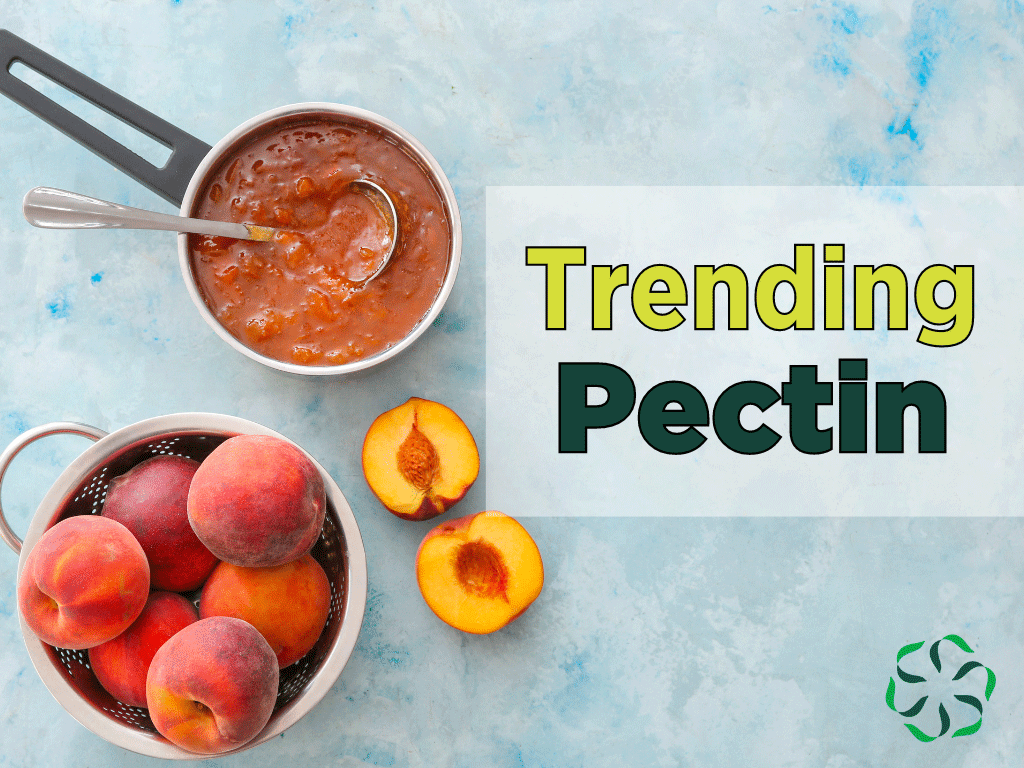Ever wonder how jam, jelly, and other sweets get their thick texture? In this blog post, we explore pectin.
What is pectin?
Pectin is a naturally occurring substance found in the cell walls of fruits and vegetables.
Some fruits are naturally richer in pectin than others. For example, apples, carrots, oranges, grapefruits, and lemons have much higher amounts of pectin compared to fruits like cherries, grapes, and other small berries. Citrus fruits contain the most pectin.
While we naturally consume pectin through fruits and vegetables, it can also be extracted from plants and used as a versatile thickening agent in food production.
What does pectin do as a thickening agent?
Extracted pectin acts as a gelling agent, so it’s commonly used to thicken jams, jellies, and fruit preserves.
Pectin is also used in various low-sugar and sugar-free products because it can create the desired texture without relying on additional sweeteners.
Additionally, we find pectin in some medications and dietary supplements (1,2).
Why is pectin important? Is it healthy?
Pectin found in fruits and vegetables helps provide necessary dietary fiber in our diets, which supports digestion, gut health, and the immune system (1,2).
It’s important to note that extracted pectin derived from fruits and used as a thickener for jams, jellies, and other foods does not provide the same dietary fiber as eating whole fruits and vegetables.
While high-sugar jams and jellies containing pectin are enjoyable, they should not replace a well-rounded, fiber-rich diet.
Pectin plays a role outside of food, too. Manufacturers use pectin in some cosmetics as a safe and natural thickener and binder. It also has medical applications and is used in some pharmaceutical and medical devices.
Is pectin plant-based? How is it made?
Yes, pectin is plant-based (not to be confused with gelatin, which is animal-based).
Pectin is typically extracted from citrus peels or apple pomace (leftover pulp from juice production) through a careful multi-step process that ensures a standardized product suitable for various uses.
There are two main types of extracted pectin designed for home cooking use:
- High Methoxyl (HM) Pectin: Gels in the presence of sugar and acid, commonly used in jams and jellies.
- Low Methoxyl (LM) Pectin: Gels in the presence of calcium, making it ideal for low-sugar or sugar-free jams and other products.
When using pectin at home, it’s important to choose the correct type for your recipe to achieve the desired result.
Pectin designed for cosmetic, supplement, or medical purposes will have different purities and properties than pectin for home cooking use.
Is pectin safe?
Pectin is a GRAS ingredient and has been used safely as a thickener for jams, jellies, and more sincethe 1800s.
Allergic reactions to pectin are extremely rare. The only known health risks are to workers in pectin manufacturing plants, who may develop respiratory issues from inhaling large amounts of pectin particles without proper safety measures (1).
Can I make and use my own pectin?
Yes, you can make pectin safely at home. However, it’s critical that you follow the outlined canning and home-preserving guidelines created by the USDA and agricultural schools.
Creating and then using pectin when canning and preserving foods requires you to follow specific protocols to ensure your canned and preserved food remains safe.
The good news.
Pectin is a natural, safe, and versatile ingredient with a long history of use in food, cosmetics, and medicine. Whether you’re making a batch of homemade jam or enjoying a low-sugar snack, pectin offers an affordable and effective way to create the perfect texture while fitting into a variety of dietary lifestyles.
If you have any questions about ingredients or ideas for a blog post, please send us an email or submit your idea to us at go.msu.edu/cris-idea.

